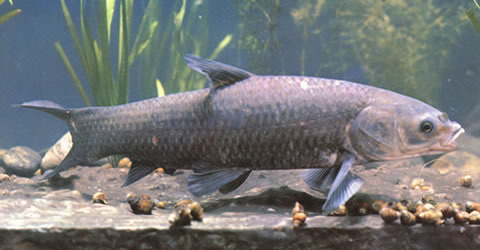| Xenocyprididae (East Asian minnows) |
| 180 cm TL (male/unsexed); max.weight: 35 kg; max. reported age: 13 years |
|
demersal; freshwater; brackish; pH range: 7.5 - 8.5; depth range 5 - 30 m, potamodromous |
| Asia: Amur river basin to southern China (Ref. 55930). Reported from Vietnam (Ref. 44416). Persists only in Europe by stocking or accidental releases; native stocks in Russia have declined sharply (Ref. 59043). Several countries reported adverse ecological impact after introduction. |
|
Dorsal spines (total): 0-0; Dorsal soft rays (total): 7-9; Anal spines: 0-0; Anal soft rays: 8-10. Anatomy of the pharyngeal apparatus is the main distinguishing characteristic; throat teeth typically form a single row of 4-5 large molariform teeth on each of the two arches, with formula typically 1,4 - 4,1. |
| Adults inhabit large lowland rivers and lakes, preferably with clear water and high oxygen concentrations. Larvae feed on zooplankton, then on ostracods and aquatic insects. At about 120 mm SL, juveniles start to prey on small snails and clams while larger juveniles and adults feed almost entirely on molluscs. Undertake upriver migration and spawns in open waters. Deposit pelagic or semipelagic eggs which hatch while drifting downstream. Larvae settle into floodplain lakes and channels with little or no current (Ref. 59043). Maximum age probably exceeds 15 years; the figure of 20 years is not supported by data (Ref. 55930). |
|
Least Concern (LC); Date assessed: 02 April 2020 Ref. (130435)
|
| potential pest |
Source and more info: www.fishbase.org. For personal, classroom, and other internal use only. Not for publication.
